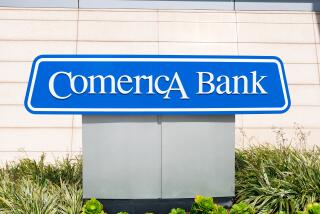American S&L; Ordered to Sell Some Securities : Drop in Interest Rates Prompts FHLBB Action
- Share via
Seeking to capitalize on the recent tumble in interest rates, federal regulators have ordered American Savings & Loan to start liquidating its huge, $18-billion portfolio of mortgage-backed securities, Federal Home Loan Bank Board member Roger Martin said in an interview Wednesday.
“We have lucked out,” said Martin, one of the three members on the board of the federal regulatory agency. “The drop in interest rates has opened a window and we’re going to take advantage of it.
The move represents a setback for American Savings Chief Executive William J. Popejoy, whose survival strategy for the ailing financial institution has rested heavily on amassing the fixed-rate, mortgage-backed securities.
“The reduction of those earnings assets will hurt us and damage our ability to carry our non-earning assets,” Popejoy said. “There’s no doubt about that.”
‘Like an Alcoholic’
The bank board has exercised significant control over American Savings since federal regulators forced the ouster of previous management in 1984. Popejoy was hired to nurse the giant financial institution back to health, but the firm has never recovered due to heavy losses in its portfolio of condominium and commercial real estate loans.
Irvine-based Financial Corp. of America, American Savings’ parent company, now has a negative net worth as a result of a $225-million loss in the fourth quarter. American Savings has nearly $34 billion in assets, second largest among the nation’s thrifts.
Martin likened American Savings to a recovering drunk trying to make it through another day. “It’s just like an alcoholic,” he said. “We’re going one day at a time.”
He also didn’t seem overly concerned about Popejoy’s objections, saying, “He disagrees with us but that’s fine.”
The bank board has already authorized an initial sale of $2.5 billion worth of the mortgage-backed securities, nearly $300 million of which were sold earlier this week for a $35-million profit, Martin said.
Martin indicated that the goal is to sell the remaining securities as--and if--interest rates continue to fall, a process that would take months in order to avoid a market disruption. “This will be an orderly liquidation,” the regulator said.
Martin noted long-term interest rates have plunged more than two percentage points since last October, sharply boosting the securities’ value. (They automatically rise in value as interest rates fall.)
As a result, potential losses in American Savings’ pool of securities have fallen from a peak of $2.6 billion on Oct. 16 to less than $500 million today. If rates fell another half of a percentage point, the entire portfolio could theoretically be sold at a profit, Popejoy calculated.
Won’t Discuss Meeting
Martin was in Los Angeles for a private meeting with executives of several major California savings and loans to discuss the possibility of selling off the American Savings branch network.
American Savings has 185 retail branches throughout the state, including more than 40 in Los Angeles County and a dozen in Orange County. Martin would not discuss what happened at the meeting.
On another front, Martin suggested that the recent failure to sell American Savings to Ford Motor Co. and its San Francisco-based First Nationwide Bank subsidiary resulted in part because the bank board didn’t want to upset the competitive balance in the California savings and loan industry.
The Ford deal fell through in part “we did not want to use money (from the Federal Savings and Loan Insurance Corp.) to give First Nationwide an unfair competitive advantage” in the California market, Martin said. He declined to elaborate.
Ford appeared close to buying American Savings several weeks ago but talks were abruptly broken off in early January. Consummation of the sale, Martin said, would have required an assistance package of $3 billion to $4 billion from FSLIC, the industry-funded government agency that pays the expense of savings and loan failures.
More to Read
Inside the business of entertainment
The Wide Shot brings you news, analysis and insights on everything from streaming wars to production — and what it all means for the future.
You may occasionally receive promotional content from the Los Angeles Times.










